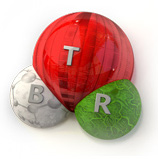Nano-forests to reveal secrets of cells
Date: 11.9.2014
Vertical nanowires could be used for detailed studies of what happens on the surface of cells. The findings are important for pharmaceuticals research, among other applications.
A group of researchers from Lund University in Sweden have managed to make artificial cell membranes form across a large number of vertical nanowires, known as a 'nano-forest'.
All communication between the interior of a cell and its surroundings takes place through the cell membrane. The membrane is a surface layer that holds the cell together and that largely comprises lipids, built of fatty acids. Inside the cell there are also various types of membrane, all with their own specific role.
Studies of cell membranes using nanotechnology have up to now mainly involved studying artificial membranes on flat surfaces, but because many membranes in the body have a curved shape, a different type of nano-surface is needed.
In a new scientific study, researchers from Lund University have used vertical nanowires to create more varied surfaces on which artificial membranes can form. The Lund researchers have built an entire forest of upright nanowires on a one millimetre squared surface, on which they have succeeded in forming artificial membranes that are curved in the same way as many natural cell membranes.






















